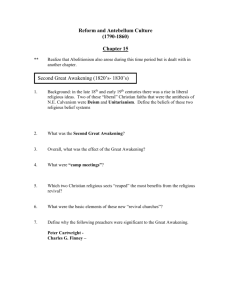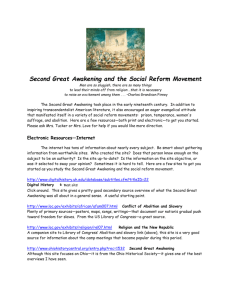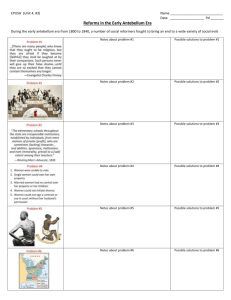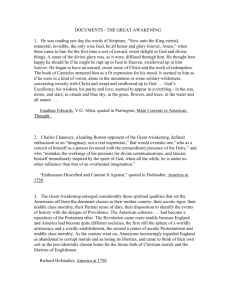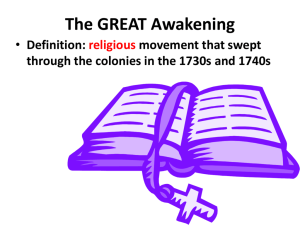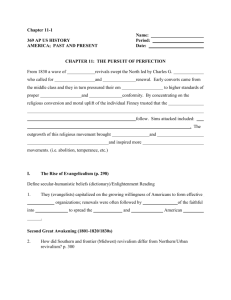2nd Great Awakening and Social Changes The 2nd Great
advertisement
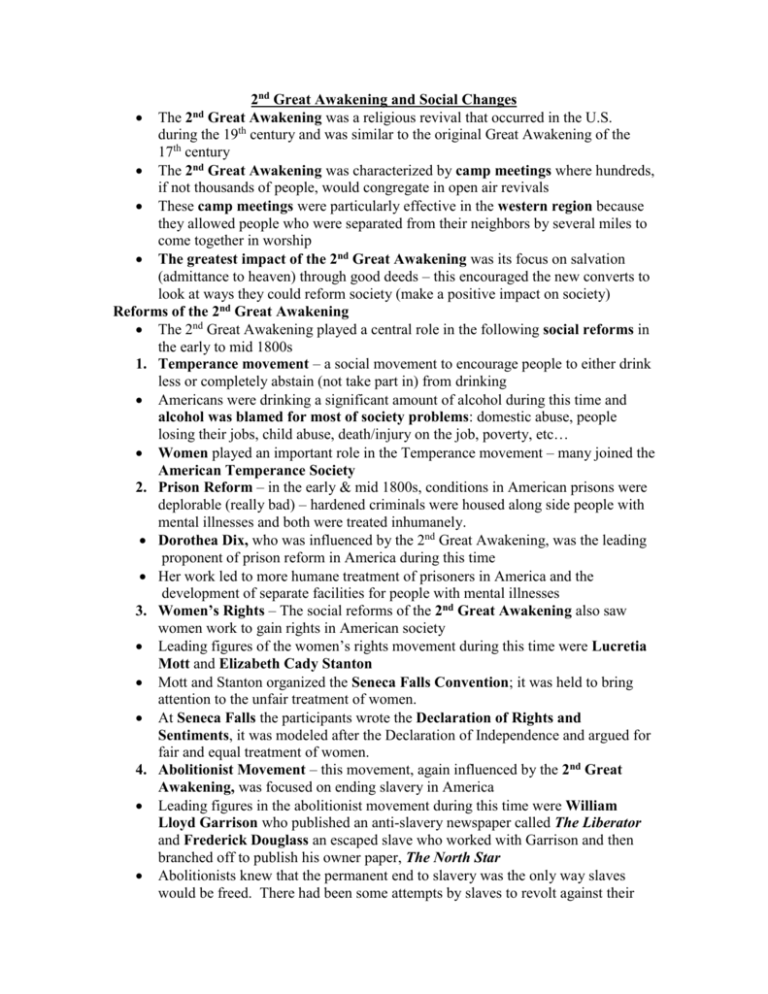
2nd Great Awakening and Social Changes The 2nd Great Awakening was a religious revival that occurred in the U.S. during the 19th century and was similar to the original Great Awakening of the 17th century The 2nd Great Awakening was characterized by camp meetings where hundreds, if not thousands of people, would congregate in open air revivals These camp meetings were particularly effective in the western region because they allowed people who were separated from their neighbors by several miles to come together in worship The greatest impact of the 2nd Great Awakening was its focus on salvation (admittance to heaven) through good deeds – this encouraged the new converts to look at ways they could reform society (make a positive impact on society) Reforms of the 2nd Great Awakening The 2nd Great Awakening played a central role in the following social reforms in the early to mid 1800s 1. Temperance movement – a social movement to encourage people to either drink less or completely abstain (not take part in) from drinking Americans were drinking a significant amount of alcohol during this time and alcohol was blamed for most of society problems: domestic abuse, people losing their jobs, child abuse, death/injury on the job, poverty, etc… Women played an important role in the Temperance movement – many joined the American Temperance Society 2. Prison Reform – in the early & mid 1800s, conditions in American prisons were deplorable (really bad) – hardened criminals were housed along side people with mental illnesses and both were treated inhumanely. Dorothea Dix, who was influenced by the 2nd Great Awakening, was the leading proponent of prison reform in America during this time Her work led to more humane treatment of prisoners in America and the development of separate facilities for people with mental illnesses 3. Women’s Rights – The social reforms of the 2nd Great Awakening also saw women work to gain rights in American society Leading figures of the women’s rights movement during this time were Lucretia Mott and Elizabeth Cady Stanton Mott and Stanton organized the Seneca Falls Convention; it was held to bring attention to the unfair treatment of women. At Seneca Falls the participants wrote the Declaration of Rights and Sentiments, it was modeled after the Declaration of Independence and argued for fair and equal treatment of women. 4. Abolitionist Movement – this movement, again influenced by the 2nd Great Awakening, was focused on ending slavery in America Leading figures in the abolitionist movement during this time were William Lloyd Garrison who published an anti-slavery newspaper called The Liberator and Frederick Douglass an escaped slave who worked with Garrison and then branched off to publish his owner paper, The North Star Abolitionists knew that the permanent end to slavery was the only way slaves would be freed. There had been some attempts by slaves to revolt against their owners, most notably Nat Turners Rebellion – but these revolts typically ended with slaves being treated more harshly. These period of history also saw the emergence of prominent anti-slavery groups on the national scene o One anti-slavery group was the American Colonization Society – their plan was to have slaves freed and send them to Africa o A second prominent anti-slavery group was American Anti-Slavery Society – its goal was the immediate end of slavery guaranteed by the federal government Transcendentalism Transcendentalism – was both a spiritual and literary movement that coincided with the 2nd Great Awakening that challenged Americans to reflect on their social, political, and economic views / values Transcendental beliefs stressed that knowledge is not based on science and reason – very person possesses an inner light that can illuminate the highest truth and put him or her in direct touch with God Transcendentalist were committed to: self-reliance, self-culture and selfdiscipline – this commitments were closely associated with social reforms of the time The leadings Transcendentalists of the time was Ralph Waldo Emerson and Henry David Thoreau o Thoreau wrote Walden: Or Life in the Woods – notable for its insistence that God could be found in nature and that people needed to set aside their desire for material goods and rely more on nature o Thoreau also wrote “On the Duty of Civil Disobedience” – as essay that argued breaking the law was morally the right thing to do if it was in protest over an immoral law Transcendentalist often formed their own communes – communities where they lived together and practiced their beliefs collectively – the best known Transcendentalist commune was Brooks Farm Transcendentalist also contributed greatly to American art – they formed an art school, The Hudson River School, where the focus was on American landscape paintings.

